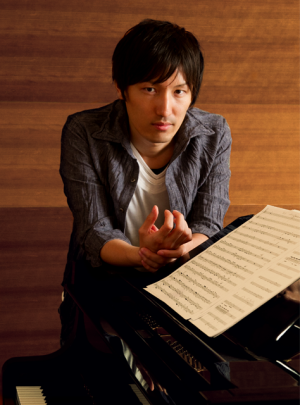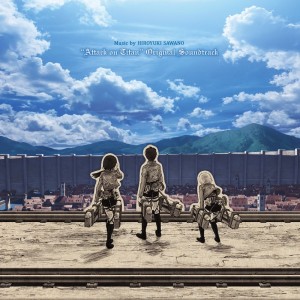The Music of Hiroyuki Sawano
April 1, 2015 · 3 comments
By Andy Hanley
 Ask the average viewer what makes a good anime series into something truly great, and they’d probably cite animation quality, visual style or something along those lines. As a result, one aspect of such productions which is often overlooked is the role that the soundtrack and incidental music which accompanies a series can play when it comes to elevating a story to greatness.
Ask the average viewer what makes a good anime series into something truly great, and they’d probably cite animation quality, visual style or something along those lines. As a result, one aspect of such productions which is often overlooked is the role that the soundtrack and incidental music which accompanies a series can play when it comes to elevating a story to greatness.
At least part of the reason that anime soundtracks tend to be overlooked is the simple fact that many of them are decidedly “by the numbers” affairs, and as such there are only a handful of composers who the average fan will even know by name, let alone have any kind of opinion of. While Yoko Kanno remains perhaps the best example of a composer with an impressive body of work within anime, recent years have seen a true rise to stardom for another equally talented individual in the form of Hiroyuki Sawano, whose compositions have come to grace a number of notable recent anime series.
Although Sawano’s work in TV, anime and movies dates back to 2006, it wasn’t until 2011 that his work in anime will have come to the attention of most fans; a year in which his music graced both the adaptation of popular manga Blue Exorcist and, perhaps more notably, Production I.G’s original work Guilty Crown.
It was the latter of these two soundtracks that really marked Hiroyuki Sawano out as one to watch – much like the work of the aforementioned Kanno, the real hook of Guilty Crown’s soundtrack was its sheer versatility, from brooding electronic rock with incessant drum beats through to confident synth-heavy pieces, and from a thunderous orchestral score that rained down upon the listener as a show of audible force through to rock-fuelled hip-hop. As a standalone work it’s incredible, but more importantly each and every track slotted impeccably into the series’ cavalcade of action set pieces and grandiose visuals. Also of import for western fans is that Hiroyuki Sawano’s music often makes use of English rather than Japanese lyrics, making it far more accessible for those of us not steeped in the Japanese language.
On that note, Guilty Crown’s soundtrack was also the moment where Sawano built up a working relationship with a powerful pair of vocalists who he’d go on to collaborate with further in the form of Mika Kobayashi and Aimee Blackschleger – a pair of notable talents in their own right.
 If Guilty Crown set the stage for this meteoric rise, it was his work on the soundtrack to Attack on Titan that really pushed Sawano into the stratosphere. The subject matter or content of this series perhaps didn’t allow for the same show of versatility, but it hammered home the strengths of his work when it came to adding majesty, drama, tension or excitement to on-screen events. It’s hard to think of a more iconic soundtrack within the sphere of anime in recent years – picture any of its memorable scenes in your head, and your brain will automatically fill in those swelling, passionate strings and thundering drum beats pushed forward by menacing synths stirring below the surface as part of your recollections. Even here there were more strings to Sawano’s proverbial bow that those big orchestral numbers – Aimee Blackschleger collaboration Doa provided the series with an iconic rock song, complete with the chorus line “Jump on the necks of monsters” for as succinct a description of Attack on Titan’s raison d’être as you could hope to find.
If Guilty Crown set the stage for this meteoric rise, it was his work on the soundtrack to Attack on Titan that really pushed Sawano into the stratosphere. The subject matter or content of this series perhaps didn’t allow for the same show of versatility, but it hammered home the strengths of his work when it came to adding majesty, drama, tension or excitement to on-screen events. It’s hard to think of a more iconic soundtrack within the sphere of anime in recent years – picture any of its memorable scenes in your head, and your brain will automatically fill in those swelling, passionate strings and thundering drum beats pushed forward by menacing synths stirring below the surface as part of your recollections. Even here there were more strings to Sawano’s proverbial bow that those big orchestral numbers – Aimee Blackschleger collaboration Doa provided the series with an iconic rock song, complete with the chorus line “Jump on the necks of monsters” for as succinct a description of Attack on Titan’s raison d’être as you could hope to find.
The success of Attack on Titan has pushed Sawano on to further success subsequently, with another turn-out of his trademark mix of orchestra and guitars on Aldnoah Zero, another incredibly versatile outing on the soundtrack of Kill la Kill, and one of several composers on Daisuke Tokudo’s Seraph of the End.
Much like Attack on Titan, it’s hard not to cast your mind over Kill la Kill’s stand-out moments without filling in Sawano’s background music in your head. Every aspect of this already superb series is accentuated by its musical treatment – Ryuko’s travails and dilemmas are transposed into music in pitch-perfect fashion (Mika Kobayashi’s imploring plea on the track Before My Body is Dry, “Don’t lose your way”, quickly established itself as a defining theme of the series itself), and characters such as Satsuki, Mako and Senketsu are summed up with consummate ease in musical terms. Throw in some bombastic electronica (the suggestive Suck Your Blood) and a slice of perfect pop music (the cheerily motivational Light Your Heart Up) and you have yourself another soundtrack that doesn’t just admirably accompany Kill la Kill, it’ll also accompany you on your drive to work or commute on the train.
Thankfully we don’t live in a world where we’re looking for “the new Yoko Kanno”, as the one that we already have is still producing stunning work within the industry (most recently on Shinichiro Watanabe’s Terror in Resonance), but as a pretender to the crown of the anime industry’s most versatile musical maestro, Sawano Hiroyuki has more than proven his credentials and guaranteed his legacy with compositions on some of the most memorable anime to reach our screens in recent years. You can only imagine that there’s plenty more where that came from, too.
Attack on Titan: Roar of Awakening, Kill la Kill and Aldnoah.Zero are available in the UK from Anime Limited.
anime, Attack on Titan, Guilty Crown, Hiroyuki Sawano, Japan, kill la kill, music, Seraph Of The End
Mike
April 1, 2015 12:09 pm
Now if only someone would gather his songs together in a place I can buy!
Jacqui
April 6, 2015 11:14 am
@Mike If you are interested Hiroyuki Sawano has recently released (Feb 2015) a best of Vocal Works cd compilation - you can find the track listing details by visiting the 'CD Japan' website. I obtained my copy via Amazon (via musicjapan).
Ryan
February 22, 2017 7:31 pm
I'd say that Gundam Unicorn was a pretty big one too, since that what caused the director of Guilty Crown and Attack on Titan to use Sawano in the first place. It's also still regarded as one of the best Gundam OSTs, and one of Sawano's best, too.